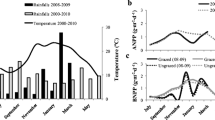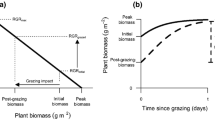Abstract
To better understand the ecological and economic benefits of short-term grazing exclusion on the aboveground net primary productivity (ANPP) of alpine pastures, we conducted annual multi-site transect surveys in the summers from 2009 to 2011 and calculated the aboveground biomass discrepancy (ABD) between grazed and ungrazed pastures at plant community and economic group levels for three zonal alpine grassland types—meadow, steppe, and desert-steppe—across the northern Tibetan Plateau. Our results indicated that aboveground biomass (AGB) significantly differed among grassland types and declined northwesterly from 64.07 to 11.44 g m−2 with decreasing precipitation and increasing temperature. The mean ABD exhibited considerable community dependency, with meadow (12.47 g m−2) > steppe (6.91 g m−2) > desert steppe (2.54 g m−2), and it declined from 25.42 to 1.29 g m−2 with decreasing precipitation and increasing temperature. ‘Good forage’, i.e. grasses and sedges, benefited most from grazing exclusion, followed by edible forbs. With longer grazing exclusion durations (GEDs), the aboveground biomass of poisonous locoweeds initially decreased and then increased compared with the adjacent grazed sites. In the nested analysis of co-variances with a general linear model, growing season precipitation (GSP; from May to September) accounted for 52.67% of the observed variation in AGB, followed by AGT (9.77 %) and pasture management systems (PMSs; grazing or grazing-excluded, 5.31 %). The variation in ABD was explained primarily by AGT (16.52 %), GED (20.25 %), and the interaction of AGT × GED (19.58 %). Our results confirm that precipitation is the primary factor controlling the ANPP of alpine grasslands on the Northern Tibetan Plateau and that the ecological benefits arising from grazing exclusion are also partly dependent on grassland type and exclusion duration. Therefore, spatial and temporal variations in growing season precipitation and plant functional traits or economic group composition should be jointly considered when developing policies concerning the management and spatial layouts of grazing exclosures in this region.




Similar content being viewed by others
Explore related subjects
Discover the latest articles, news and stories from top researchers in related subjects.References
Harris RB (2010) Rangeland degradation on the Qinghai-Tibetan plateau: a review of the evidence of its magnitude and causes. J Arid Environ 74:1–12
Wei XH, Yang P, Li S et al (2008) Effects of over grazing on plant species diversity of Alpine kobresia (Kobresia pygmaea) meadow in Tibet. Proc China Assoc Sci Technol 4:190–197
Cao J, Holden NM, Lu XT et al (2011) The effect of grazing management on plant species richness on the Qinghai-Tibetan Plateau. Grass Forage Sci 66:333–336
Zhou HK, Tang YH, Zhao XQ et al (2006) Long-term grazing alters species composition and biomass of a shrub meadow on the Qinghai-Tibet Plateau. Pak J Bot 38:1055–1069
Wu JS, Zhang XZ, Shen ZX et al (2012) Species richness and diversity of alpine grasslands on the northern Tibetan Plateau: effects of grazing exclusion and growing season precipitation. J Resour Ecol 3:236–242
Wu JS, Zhang XZ, Shen ZX et al (2013) Grazing-exclusion effects on aboveground biomass and water-use efficiency of alpine grasslands on the northern Tibetan Plateau. Rangel Ecol Manag 66:454–461
Li SX, Wang QJ, Jing ZC et al (2009) Effects of protective enclosure on vegetation diversity, and productivity of degraded Alpine kobresia meadow (Qinghai-Tibetan Plateau). Pol J Ecol 57:495–502
Wu GL, Du GZ, Liu ZH et al (2009) Effect of fencing and grazing on a Kobresia-dominated meadow in the Qinghai-Tibetan Plateau. Plant Soil 319:115–126
Shang ZH, Deng B, Ding LM et al (2013) The effects of 3 years of fencing enclosure on soil seed banks and the relationship with above-ground vegetation of degraded alpine grasslands of the Tibetan plateau. Plant Soil 364:229–244
Lunt ID, Eldridge DJ, Morgan JW et al (2007) A framework to predict the effects of livestock grazing and grazing exclusion on conservation values in natural ecosystems in Australia. Aus J Bot 55:401–415
Schultz NL, Morgan JW, Lunt ID (2011) Effects of grazing exclusion on plant species richness and phytomass accumulation vary across a regional productivity gradient. J Veget Sci 22:130–142
Courtois DR, Perryman BL, Hussein HS (2004) Vegetation change after 65 years of grazing and grazing exclusion. J Range Manage 57:574–582
Mayer R, Kaufmann R, Vorhauser K et al (2009) Effects of grazing exclusion on species composition in high-altitude grasslands of the Central Alps. Basic Appl Ecol 10:447–455
Deleglise C, Loucougaray G, Alard D (2011) Spatial patterns of species and plant traits in response to 20 years of grazing exclusion in subalpine grassland communities. J Veg Sci 22:402–413
Osem Y, Perevolotsky A, Kigel J (2004) Site productivity and plant size explain the response of annual species to grazing exclusion in a Mediterranean semi-arid rangeland. J Ecol 92:297–309
Ma WH, He JS, Yang YH et al (2010) Environmental factors covary with plant diversity-productivity relationships among Chinese grassland sites. Glob Ecol Biogeogr 19:233–243
Yang YH, Fang JY, Fay PA et al (2010) Rain use efficiency across a precipitation gradient on the Tibetan Plateau. Geophys Res Lett 37:L15702
Ding MJ, Zhang YL, Liu LS et al (2007) The relationship between NDVI and precipitation on the Tibetan Plateau. J Geograph Sci 17:259–268
Li XJ, Zhang XZ, Wu JS et al (2011) Root biomass distribution in alpine ecosystems of the northern Tibetan Plateau. Environ Earth Sci 64:1911–1919
Wu J, Shen Z, Zhang X (2014) Precipitation and species composition primarily determine the diversity–productivity relationship of alpine grasslands on the Northern Tibetan Plateau. Alp Bot. doi:10.1007/s00035-014-0125-z
Yang YH, Fang JY, Pan YD et al (2009) Aboveground biomass in Tibetan grasslands. J Arid Environ 73:91–95
Cao GM, Tang YH, Mo WH et al (2004) Grazing intensity alters soil respiration in an alpine meadow on the Tibetan Plateau. Soil Biol Biochem 36:237–243
Hutchinson M. Anusplin Version 4.3. Centre for Resource and Environmental Studies. The Australian National University: Canberra, Australia, 2004
Mladek J, Mladkova P, Hejcmanova P et al (2013) Plant trait assembly affects superiority of grazer’s foraging strategies in species-rich grasslands. PLoS One 8:e69800
Hu ZM, Yu GR, Fan JW et al (2010) Precipitation-use efficiency along a 4500-km grassland transect. Glob Ecol Biogeogr 19:842–851
Guo Q, Hu ZM, Li SG et al (2012) Spatial variations in aboveground net primary productivity along a climate gradient in Eurasian temperate grassland: effects of mean annual precipitation and its seasonal distribution. Glob Change Biol 18:3624–3631
Bai YF, Wu JG, Xing Q et al (2008) Primary production and rain use efficiency across a precipitation gradient on the Mongolia plateau. Ecology 89:2140–2153
Lane DR, Coffin DP, Lauenroth WK (2000) Changes in grassland canopy structure across a precipitation gradient. J Veg Sci 11:359–368
Sala OE, Parton WJ, Joyce LA et al (1988) Primary production of the central grassland region of the United-States. Ecology 69:40–45
Luo TX, Li WH, Zhu HZ (2002) Estimated biomass and productivity of natural vegetation on the Tibetan Plateau. Ecol Appl 12:980–997
Song M, Duan D, Chen H et al (2008) Leaf δ 13C reflects ecosystem patterns and responses of alpine plants to the environments on the Tibetan Plateau. Ecography 31:499–508
Fan JW, Wang K, Harris W et al (2009) Allocation of vegetation biomass across a climate-related gradient in the grasslands of Inner Mongolia. J Arid Environ 73:521–528
Shaver GR, Jonasson S (1999) Response of Arctic ecosystems to climate change: results of long-term field experiments in Sweden and Alaska. Polar Res 18:245–252
Sala OE, Gherardi LA, Reichmann L et al (2012) Legacies of precipitation fluctuations on primary production: theory and data synthesis. Philos T R Soc B 367:3135–3144
Wu JS, Li XJ, Shen ZX et al (2012) Specie richness distribution pattern of alpine grasslands communities along a precipitation gradient across Northern Tibetan Plateau. Acta Prataculturae Sin 21:17–25
Leps J, Osbornovakosinova J, Rejmanek M (1982) Community stability complexity and species life-history strategies. Vegetatio 50:53–63
Wang GH, Li H, An M et al (2011) A regional-scale consideration of the effects of species richness on above-ground biomass in temperate natural grasslands of China. J Veg Sci 22:414–424
Acknowledgements
This work was supported by the National Natural Science Foundation of China (41171044), Knowledge Innovation Project of the Chinese Academy of Sciences (XDB03030401 & KZCXZ-XB3-08), and by a General Financial Grant from the China Postdoctoral Science Foundation (2013M530716).
Author information
Authors and Affiliations
Corresponding author
About this article
Cite this article
Wu, J., Zhang, X., Shen, Z. et al. Effects of livestock exclusion and climate change on aboveground biomass accumulation in alpine pastures across the Northern Tibetan Plateau. Chin. Sci. Bull. 59, 4332–4340 (2014). https://doi.org/10.1007/s11434-014-0362-y
Received:
Accepted:
Published:
Issue Date:
DOI: https://doi.org/10.1007/s11434-014-0362-y




